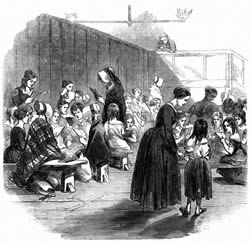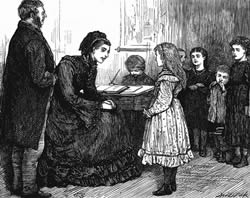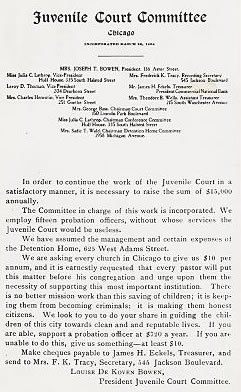Thought-Provoking Exercise
Post your thoughts to the Lesson 2 Child Saving Movement discussion forum in Lesson 2 folder.
|
One of the most cited authors related to the 19th century “child saving” movement is Tony Platt. In The Child Savers: The Invention of Delinquency (1977; University of Chicago Press), Platt talks about the rise of America’s middle and upper classes. The primarily Protestant majority’s lifestyle placed a heavy emphasis on conformity and self-reliance. Further, this majority became increasingly concerned about the rising lower classes, situated in the new urban areas, and the notion that this new class of people threatened the more general ideas about civilized society. Also referred to as a period of reformation (1890-1914), so-called progressives thought it in the best interest of society to put into place certain mechanisms to protect society from the rising ranks of the dangerous classes. The purpose of this lesson is to demonstrate the major philosophies associated with the child-saving movement and the role that this movement played on the ushering in of a separate system of justice for young people.
By the end of this lesson, you should be able to:
Post your thoughts to the Lesson 2 Child Saving Movement discussion forum in Lesson 2 folder.
|
Read Chapters 1 and 2 in Sims and Preston (2006).You are expected to have completed the reading before you proceed to the instructor's commentaries for this lesson.
 According to Platt, women played a major role in this child-saving movement. Middle- and upper-class women began to agitate for methods through which the children of immigrants, the majority of those children found in the new urban underclass, could be brought under the guidance of more appropriate caretakers. The industrial revolution had elevated a new middle class which joined the ranks of the upper class when it came to ideas about child rearing practices, how one should keep the home, etc. Most households in these middle and upper economic strata were able to hire and maintain domestic help. Having some assistance in running their own households, women became interested in more and more social causes, volunteer work, and political issues of the time.
According to Platt, women played a major role in this child-saving movement. Middle- and upper-class women began to agitate for methods through which the children of immigrants, the majority of those children found in the new urban underclass, could be brought under the guidance of more appropriate caretakers. The industrial revolution had elevated a new middle class which joined the ranks of the upper class when it came to ideas about child rearing practices, how one should keep the home, etc. Most households in these middle and upper economic strata were able to hire and maintain domestic help. Having some assistance in running their own households, women became interested in more and more social causes, volunteer work, and political issues of the time.
As was seen in Lesson 1, rapid industrialization and immigration produced disorganized communities centered at the hub of work in urban areas. The reformers, or child savers, viewed the children of this new working class as troublesome and capable of wreaking havoc on the “American” way of life. Indeed, this new class of people, growing almost exponentially in numbers, was viewed by the middle and upper classes as capable of catapulting society downward into chaos and depravity. Women, then, took it upon themselves to step in, with the authority of the state behind them, to get control over these wayward youth; the intention of which was to save the children from poor parenting and living conditions that would soon push them into a life of crime.
Thus, Platt and others have suggested that the child savers were not exclusively concerned about what was best for the children of the working classes. Rather, it was a growing fear that unless something was done about it, the rising urban underclass would grow in numbers and its cultural norms and traditions, e.g. its way of life, would soon replace those of the middle and upper class Americans.
 One of the ways in which middle and upper class child savers, and in conjunction with the state, were able to get control over so-called wayward youth was to remove them from their homes and place them in houses of refuge. These were unique institutions established to re-train the child in how to behave like a good and civilized citizen. These institutions sought to instill in children the notions of hard work, delayed gratification, clean living, responsibility, and self-reliance. Beginning in Northeastern regions of the U.S., these houses of refuge quickly spread across the U.S. and into both urban and rural areas.
One of the ways in which middle and upper class child savers, and in conjunction with the state, were able to get control over so-called wayward youth was to remove them from their homes and place them in houses of refuge. These were unique institutions established to re-train the child in how to behave like a good and civilized citizen. These institutions sought to instill in children the notions of hard work, delayed gratification, clean living, responsibility, and self-reliance. Beginning in Northeastern regions of the U.S., these houses of refuge quickly spread across the U.S. and into both urban and rural areas.
 With the establishment of mechanisms of social control, e.g. ways through which the middle and upper classes could gain control over the children of the lower classes, it was just a matter of time before this somewhat informal system would be developed into a more formal one. The child saving movement was one of the most powerful grassroots movements in the history of the U.S. Along with the establishment of houses of refuge, mandatory schooling was put into place, and the state came to be seen as a legitimate source of parenting, to take the place of parents who were viewed as unable or unwilling to manage unruly children. The creation of the first separate justice system for children was in 1899 in Cook County, Illinois (Chicago). This system, however, had been set in place long before it was formalized. As noted above, although some viewed the child savers as having their hearts in the right place, others argue strongly just the opposite. The new court was to extend the underlying philosophy of the movement to get control over what was viewed a major threat to "good" society. In this new system, a new language was created to address the new "juvenile" offender. These youthful offenders were not be called "criminals" as were adults who broke the law. These offenders would be "taken into custody" as opposed to being "arrested." This new "juvenile" would be "adjudicated a delinquent" as opposed to being "convicted." He or she would serve time, if need be, in a "juvenile holding facility" as opposed to being placed in a "jail or prison." All of these new terms were a direct hold over from the child saving movement and the progressiveness of these reformers and their belief that children should be treated differently from adults.
With the establishment of mechanisms of social control, e.g. ways through which the middle and upper classes could gain control over the children of the lower classes, it was just a matter of time before this somewhat informal system would be developed into a more formal one. The child saving movement was one of the most powerful grassroots movements in the history of the U.S. Along with the establishment of houses of refuge, mandatory schooling was put into place, and the state came to be seen as a legitimate source of parenting, to take the place of parents who were viewed as unable or unwilling to manage unruly children. The creation of the first separate justice system for children was in 1899 in Cook County, Illinois (Chicago). This system, however, had been set in place long before it was formalized. As noted above, although some viewed the child savers as having their hearts in the right place, others argue strongly just the opposite. The new court was to extend the underlying philosophy of the movement to get control over what was viewed a major threat to "good" society. In this new system, a new language was created to address the new "juvenile" offender. These youthful offenders were not be called "criminals" as were adults who broke the law. These offenders would be "taken into custody" as opposed to being "arrested." This new "juvenile" would be "adjudicated a delinquent" as opposed to being "convicted." He or she would serve time, if need be, in a "juvenile holding facility" as opposed to being placed in a "jail or prison." All of these new terms were a direct hold over from the child saving movement and the progressiveness of these reformers and their belief that children should be treated differently from adults.
In the dawn of the 20th century, there was a strong belief that scientific methods and rationality would produce new ways of addressing the crime problem in the United States. A greater emphasis was placed on the role that social conditions play in the production of crime. The emergence of psychology as a field of study resulted in a simultaneous belief that understanding better the role of childhood development would lead to a reduction in criminality if problem behaviors were identified and treated early in the life of a problem child. The new court would attack the problem of delinquency on two fronts:
Under this “medical model,” the new court would act as a parent of the child who came under its control. As such, the court was viewed primarily as civil in nature; not criminal in nature. Unlike the adult justice system with an emphasis on punishment, the new juvenile court would focus on rehabilitation and returning each child to society as a law abiding citizen. And because the court was not out to punish children, there would be no need to ensure that “delinquents” were given the same constitutional protections as were the adult criminal.
The child saving movement played a major role in the creation of a separate justice for young people in the United States. There remains a controversy as to whether these reformers had the best interest of children in mind when they created the houses of refuge and the new justice system. The question remains, “Where these child savers really interested in maintaining a way of life that the children of the working classes seem to threaten?” A second question that will addressed in subsequent lessons, beginning in Lesson 3, is, “Has the separate justice system for juveniles been able to live up to its promise of providing individualized treatment for each child it places under its custody?” Finally, it seems useful to ask the question, “How different is today’s juvenile justice system from the adult justice system?”
 Wrap-Up Activity: Identifying Peer-Reviewed Article I
Wrap-Up Activity: Identifying Peer-Reviewed Article ISims, Barbara. (1997). “Crime, Punishment, and the American Dream: Toward a Marxist Integration.” Journal of Research in Crime and Delinquency, 34 (1): 5-24.